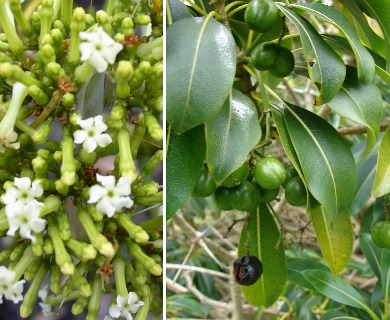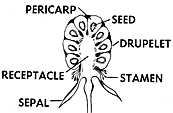Hao
Rauvolfia sandwicensis
Dogbane family (Apocynaceae)
Native species ()
Hao is a variable species of small native trees or shrubs widespread in mainly dry areas, characterized by milky sap, elliptical or oblong light green leaves mostly 4–5 at ringed small greenish yellow or whitish tubular flowers, and two- black A small tree 20 ft (6 ) high, sometimes to 40 ft (12 ), and 1 ft (0.3 ) in trunk diameter, or a shrub. Bark light gray, smooth or lightly fissured. Inner bark yellowish or brown streaked with pink, bitter, when cut exuding white, slightly bitter sap or latex. Twigs stout, hairless, light green, turning gray, with raised half-round leafscars at ringed

©2003 Forest And Kim Starr
Flower clusters () mostly branched. Flowers many, crowded, nearly stalkless, fragrant, 3⁄8– 1⁄2 inch (10–13 ) long, composed of green of five pointed overlapping greenish yellow or whitish narrow tubular with five rounded overlapping spreading five small inside tube, and with two ovaries, threadlike and long
() are two- about 1⁄2 inch (13 ) long and broad, slightly flattened and heart-shaped, with at base, black, fleshy.
Sapwood is light yellow and heartwood deep reddish brown. Moderately heavy, fine-textured, moderately hard, durable, straight-grained and without growth rings. Not used by the Hawaiians for fuel because the smoke was thought to be poisonous, nor for charcoal because it burned completely to ashes. It was, however, considered a good wood for construction.
Scattered mostly in dry forests on leeward slopes to about 2000 ft (610 ) altitude. A stunted shrub on a‘a rough lava flows.
Special area
Volcanoes
Range
Hawaiian Islands only
Other common name
devilpepper
Botanical
Rauvolfia degeneri Sherff, R. forbesii Sherff, R. helleri Sherff, R. mauiensis Sherff, R. molokaiensis Sherff, R. remotiflora Deg. & Sherff
This variable species was divided into seven differing mainly in sizes of leaves and flowers (Sherff 1947). The six segregates were questioned in a monograph by Rao (1956) and are treated here as
The Rauvolfia (formerly also spelled Rauwolfia) commemorates Leonhard Rauwolf (1535–96), German botanist and physician. He collected plants and made an early herbarium on his travels through the Near East in 1573–75.








